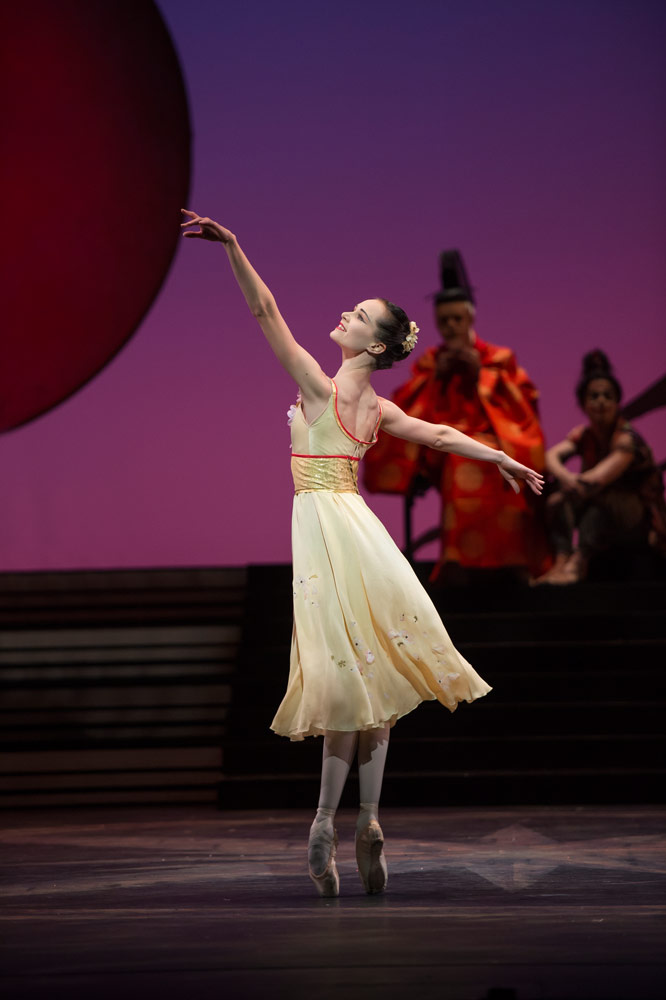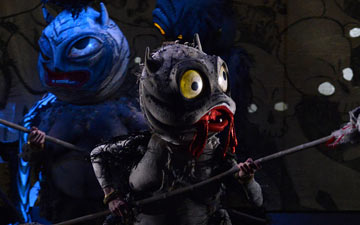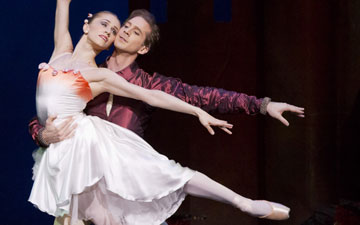
© Bill Cooper. (Click image for larger version)
Birmingham Royal Ballet
The Prince of the Pagodas
London, Coliseum
27 March 2014
www.brb.org.uk
David Bintley, the Artistic Director of Birmingham Royal Ballet has a strong commitment to new family friendly full length narrative classical ballets. His Prince of the Pagodas follows on from his Cinderella, performed at the Coliseum in 2011 and Aladdin in 2013. Both these showed us a clear easy-to-follow exposition of narrative, and some beautiful and eye-catching designs.
Pagodas follows on in this vein, this time with designs by Rae Smith (the designer of the National Theatre’s hit production, War Horse) new to ballet but fizzing with ideas. The action is placed in Japan and Bali. The designs are wonderfully colourful and endlessly inventive, a real pleasure to the eye. But as with Bintley’s Aladdin, the glorious sets and costumes remain in the memory longer than some of the choreography. He has made another attractive story ballet but though it entertains there are no deeper resonances. Britten’s score takes us on a journey to the land of the Pagodas with its imitation of the gamelan, and suggests a real complexity of feeling and contradictory impulses. But this production does not investigate the potentially darker elements of attraction to, and repulsion from, the Salamander Prince. Bintley’s heroine Belle remains conventionally pretty through it all, a little distressed, but ultimately not profoundly changed. Despite Bintley’s fondness for ballets with a theme of transformation (Beauty and the Beast is another example) the emotional impact of those transformations is not explored in depth in the choreography itself.
Bintley’s reworking of the narrative, so that Princess Belle’s Salamander Prince is her long-lost brother with whom she is reunited (rather than a lover), and Épine is her wicked stepmother, is clear to follow. A scene making good use of young students cleverly shows us the moment of the brother’s transformation. But having our hero and heroine as brother and sister sits quite oddly with their final big pas de deux, after their triumph. We are so used to reading the grammar of this as a woman and man attracted to one another that the emotional pay-off is reduced.

© Bill Cooper. (Click image for larger version)
One of Bintley’s other notable commitments as Director is the rapid development of young dancers. For a graduating dance student, hungry for big roles, BRB is the company to aim for. Other companies may keep their recent graduates in the corps for some time before offering meaty roles. The Salamander Prince at this performance was First Artist William Bracewell, who graduated from the Royal Ballet School in 2010. (Another notable example of early chances at big roles at BRB is Yaoquian Shang, who graduated from the Royal Ballet School in 2013 and appeared as Belle at the matinee).
Bracewell has already appeared as Oberon in The Dream with BRB. This was a very impressive and assured performance. We have a tantalisingly brief glimpse of him as Prince rather than Salamander early on in a brief duet with his sister which showed elegant lines and secure partnering. He slithered and wriggled with abandon as the Salamander but I was keen to see him back as a prince, and he certainly didn’t disappoint. He looked assured, entirely ready for major roles and seemed a very sympathetic partner.

© Bill Cooper. (Click image for larger version)
Belle was the experienced principal Jenna Roberts. She has an attractive, fluid, limpid quality, and wonderfully quiet feet. Her dancing projected much more strongly than any acting. We do not get introduced to Belle until after the four kings, her suitors have already appeared and shown the aggression in their characters. Perhaps if we had seen her earlier we might have had a greater sense of investment in her fate. She is charming but shouldn’t we be more engaged with her and worried about what might happen? It seems the role is underwritten.
Samara Downs, a soloist, was cast as the wicked stepmother Épine. She has plenty of dancing to do, partnered by the four kings in a variety of different styles. Her character came across more forcefully than anyone else on stage. Nevertheless I suspect Bintley the choreographer is more interested or maybe more successful at making dance for men rather than women.

© Bill Cooper. (Click image for larger version)
The four kings in this production, the suitors for Belle, are strongly delineated and each given a very distinctive movement vocabulary, which sticks in the mind rather more than any of the steps for the women. Here Bintley seems at his most responsive to Britten’s score. The effect is heightened by Rae Smith’s gorgeous costumes. Tyrone Singleton as the King of the South still keeps his composure even under a ruff of ostrich feathers. In Act 2, where Belle journeys to the Land of the Pagodas, the most interesting dancing she meets on the way comes from four men as seahorses, evoking some echoes of de Valois’s Checkmate.

© Bill Cooper. (Click image for larger version)
Benjamin Britten’s score is both a blessing and a curse. Cranko and Macmillan both used it without total success. There are wonderful moments in there, and in the opening act Bintley does make a good case for this as truly danceable music. The Royal Ballet Sinfonia under Paul Murphy make the most of the gamelan moments. This is the full score, and it means a long evening in the theatre. In Act 2 it is hard to keep up the flow of invention and incident in the dance. It is possible for the mind to wander and start querying the narrative. If Belle escapes from the court together with the Salamander at the end of Act 1 where has he gone now? And just why is Épine following Belle dressed as an octopus?
Nevertheless, it is consistently gorgeous to look at. The monsters (Yokai) who accompany the Salamander, with their huge heads and glowing eyes, will enchant any eight year old. The audience certainly enjoyed the spectacle. This production is an uncomplicated piece of family entertainment. Britten’s Prince of the Pagodas could be more than that, but it still has not found its ideal interpreter.

© Roy Smiljanic. (Click image for larger version)

















You must be logged in to post a comment.